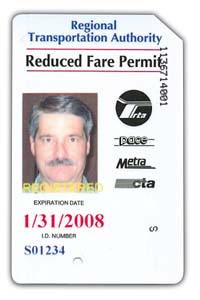Trip Tickets


The shift to cards from coins emphasizes several levels of increased security: there’s less internal theft and loss by eliminating cash handling; transit systems can more easily issue specialty identification cards for reduced fare, student and disabled passenger use; and money can be protected more quickly if a smart card is lost or stolen.
The Regional Transportation Authority (RTA) in Chicago works with an outside vendor to produce reduced fare permit photo ID cards for seniors and people with disabilities. The provider, Polaroid Commercial ID Systems of Waltham, Mass., produces the cards in its Ft. Wayne, Ind., facility.

Outsourcing Saves Resources
“Polaroid’s ability to provide a low-cost solution with rapid distribution response has allowed the RTA to manage its program without capital equipment costs or additional personnel,” says Vickie Bradley, RTA's customer service supervisor.The RTA is responsible for funding, regional planning and fiscal oversight of all public transportation in six northeastern Illinois counties. Since 1975, the Authority has issued reduced fare cards, allowing senior citizens and disabled passengers to ride at 50 percent of full-fare cost. From the outset, the RTA outsourced management of this specific program, conducting an open bid process every four or five years.
The RTA customer service department and a network of 200 volunteer registration centers assist people to apply for the reduced fare permit. Applicants must submit government-issued identification and a photo. Some centers can snap a photo if one does not exist. The applications and photos go to the Polaroid Ft. Wayne office, where the process leads to the mailing of an ID card where applicable. This year, RTA migrates to an automated process using a Web-enabled system.
Nearly 100,000 ID cards are issued annually
In another regional transit arena, the Washington Metropolitan Area Transit Authority is developing a smart card-based fare collection system for that area.The project involves ERG Group, an Australian firm specializing in transit smart cards, and Northrop Grumman Corporation’s Information Technology sector of Herndon, Va.
In development is the SmarTrip card, a project that will enable residents of the Washington, D.C., Maryland and northern Virginia metro area to use one card to pay fares across multiple transit systems.
The system, which is expected to grow to a card base of more than one million over a five-year period, will interface with existing installed hardware such as gates and readers.
Beyond transit systems and consumer smart cards, Northrop Grumman is involved in the largest, most influential U.S. smart card project – the Common Access Card or CAC program. The defense contractor has middleware that allows smart cards to communicate with computers and computer applications. Specifically, the middleware under development is for signing and encrypting email, cryptologic network login, client authentication for Web sites and secure data transmission to other applications such as virtual private network, remote access and work flow.
Smart cards, gaining in corporate, government and financial applications, are computer chip-based identification tokens capable of enabling the personal identification and authentication process. The CAC is the U.S. Department of Defense version issued to all active duty, guard and reserve personnel. Many security technologists feel that the standards being set by the CAC effort will set the tone for future smart card developments outside of government and military applications.
Smart cards and multi-technology identification badges are making significant inroads into corporate and commercial applications. A number of vendors now offer transitional cards that blend proximity and smart card technologies and the cost of chip cards is decreasing, too.
Sidebar: Smart Cards in Space
The U.S. General Services Administration awarded a $93 million task order to NASA in developing a state-of-the-art smart card for agency employees and contractors to access facilities and information systems, according to the Smart Card Alliance Web site. The “One NASA” smart card will enhance physical security for NASA facilities by authenticating an individual’s identity. It will also provide a higher level of identity assurance for the agency’s information technology systems. With the smart card, employees and contractors swipe it across or insert it in a reader to access a NASA center, facility or computer system.Looking for a reprint of this article?
From high-res PDFs to custom plaques, order your copy today!





